Cyclone Megan Damages Top Manganese Mine in Northern Australia
One of the world's leading manganese mines faced significant damage on Monday as Cyclone Megan battered the northern regions of Australia. Reports indicate that the damage to the dock is extensive, requiring substantial repairs.
Groote Eylandt Mining Company (GEMCO), based in Australia and jointly owned by South32 and Anglo-American, has confirmed the suspension of operations at their facility as they assess the structural damage caused by cyclone Megan.
Tropical Cyclone Megan has made landfall in Australia's Northern Territory! 🇦🇺
Fortunately, the cyclone made landfall in a sparsely populated area of the Northern Territory, greatly reducing its impact, and is anticipated to rapidly weaken.#CycloneMegan pic.twitter.com/tio5wJOHss
— WeatherNation (@WeatherNation) March 18, 2024
Source: Twitter/WeatherNation
Vessel Collision Adds to Woes
According to reports from the Australian Financial Review, the Cyprus-registered bulker Anikitos (31,236 dwt) was driven into the dock during the cyclone Megan. Although unconfirmed, there are speculations of hull damage to the 623-foot (190-meter) bulker, which was loading ore at the time.
It's reported to have loaded 41,000 tonnes of metal before the storm struck, failing to depart in time. Divers are set to examine the vessel's hull for any potential damage.
Impact of Cyclone Megan on Groote Eylandt
Cyclone Megan, classified as a "severe tropical cyclone" by the Australian Meteorological Service, made landfall on Monday afternoon, bringing peak wind speeds of 105 mph and an average range of 70 to 80 mph.
The cyclone Megan was forecasted to deliver between 12 to 19 inches of rainfall. Although Groote Eylandt, situated about 400 miles east of Darwin in the Gulf of Carpentaria, did not face a direct hit, it experienced strong winds and heavy rain.
Manganese Mining Operations Disrupted
Groote Eylandt serves as a crucial hub for manganese mining and exports, with reports indicating that 10 to 12 ships load over 50,000 tonnes of manganese each month for export. In 2023, the mine produced 5.9 million tonnes of manganese, with a significant portion destined for China. The Anikitos, shuttling between Australia and South Korea, is instrumental in transporting these exports.
GEMCO’s Challenges and Industry Response
GEMCO stands as the sole mining company on the island and had plans for expanding its mining operations. Meanwhile, Glencore, another mining company operating a zinc mining operation in the region, took precautionary measures by evacuating workers ahead of the storm. The forecast suggests that the cyclone will weaken as it moves inland overnight and into Tuesday.
Understanding Cyclones: Formation and Impact
Cyclones, also known as hurricanes or typhoons depending on the region, are powerful tropical storms characterized by low-pressure centers and strong winds circulating in a counterclockwise direction in the Northern Hemisphere and clockwise in the Southern Hemisphere. These massive weather systems can cause extensive damage to coastal areas through heavy rainfall, storm surges, and high winds.
Formation of Cyclones
Cyclones typically form over warm ocean waters near the equator, where sea surface temperatures are typically 26.5 degrees Celsius (80 degrees Fahrenheit) or higher.
As the warm air rises, it creates an area of low pressure at the surface. Surrounding air rushes in to fill the void, creating a swirling motion. If the conditions are right, with minimal wind shear and high humidity, this swirling system can intensify into a cyclone.
Several factors contribute to the development and intensification of cyclones, including the Coriolis effect, which causes the rotation of the Earth to influence the direction of the winds; the presence of an area of disturbed weather, such as a tropical wave or low-pressure system; and warm ocean waters acting as a source of heat and moisture.
Impact of Cyclones
Once formed, cyclones can unleash devastating effects on coastal communities. Heavy rainfall can lead to widespread flooding, while strong winds can cause structural damage to buildings, uproot trees, and generate dangerous storm surges that inundate coastal areas. The combination of these factors often results in significant property damage, loss of life, and disruption to essential services such as power, water, and transportation.
In addition to the immediate impact on coastal regions, cyclones can also have far-reaching effects inland, causing flooding, landslides, and infrastructure damage. The aftermath of a cyclone may require extensive recovery and rebuilding efforts to restore affected communities to normalcy.
Read more such news on techinsighttoday
Thank you so much for reading.

